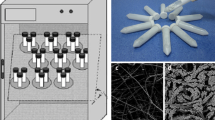Abstract
We have compared three different production methods, which may be suitable for the large scale production of adenovirus vectors for human clinical trials. The procedures compared 293 cells adapted to suspension growth in serum-free medium in a stirred tank bioreactor, 293 cells on microcarriers in serum-containing medium in a stirred tank bioreactor, and 293 cells grown in standard tissue culture plasticware. With a given virus, yields varied between 2000 and 10,000 infectious units/cell. The stirred tank bioreactor routinely produced between 4000 and 7000 infectious units/cell when 293 cells were grown on microcarriers. The 293 cells adapted to suspension growth in serum-free medium in the same stirred tank bioreactor yielded between 2000 and 7000 infectious units/cell. Yields obtained from standard tissue culture plasticware were up to 10,000 infectious units/cell. Cell culture conditions were monitored for glucose consumption, lactate production, and ammonia accumulation. Glucose consumption and lactate accumulation correlated well with the cell growth parameters. Ammonia production does not appear to be significant. Based on virus yields, ease of operation and linear scalability, large-scale adenovirus production seems feasible using 293 cells (adapted to suspension/serum free medium or on microcarriers in serum containing medium) in a stirred tank bioreactor.
Similar content being viewed by others
References
Crystal R (1995) Transfer of genes to humans: early lessons and obstacles to success. Science 270: 404-409.
Garnier A, Cote J, Nadeau I, Kamen A and Massie B (1994) Scale-up of the adenovirus expression system for the production of recombinant protein in human 293S cells. Cytotechnol 15: 145-155.
Jones N and Shenk T (1979) An adenovirus type 5 early gene function regulates expression of other early viral genes. Proc Natl Acad Sci USA 76: 3665-3669.
Nadeau J, Garcier A, Cote J, Massie B, Chavarie C and Kamen A (1996) Improvement of recombinant protein production with the human adenovirus/293S expression system using fed-batch strategies. Biotechnol Bioeng 51: 613-623.
Nahapetian A, Thomas J and Thilly W (1986) Optimization of environment for high density vero cell culture. Effect of dissolved oxygen and nutrient supply on cell growth and changes in metabolites. J Cell Sci 81: 65-103.
Schmidt N and Emmons R (1989) Diagnostic Procedures for Viral, Rickettsial and Chlamydial Infections. (pp 18-21) Sixth Edition, American Public Health Association, Washington, D.C.
Author information
Authors and Affiliations
Rights and permissions
About this article
Cite this article
Iyer, P., Ostrove, J.M. & Vacante, D. Comparison of manufacturing techniques for adenovirus production. Cytotechnology 30, 169–172 (1999). https://doi.org/10.1023/A:1008040221630
Issue Date:
DOI: https://doi.org/10.1023/A:1008040221630




